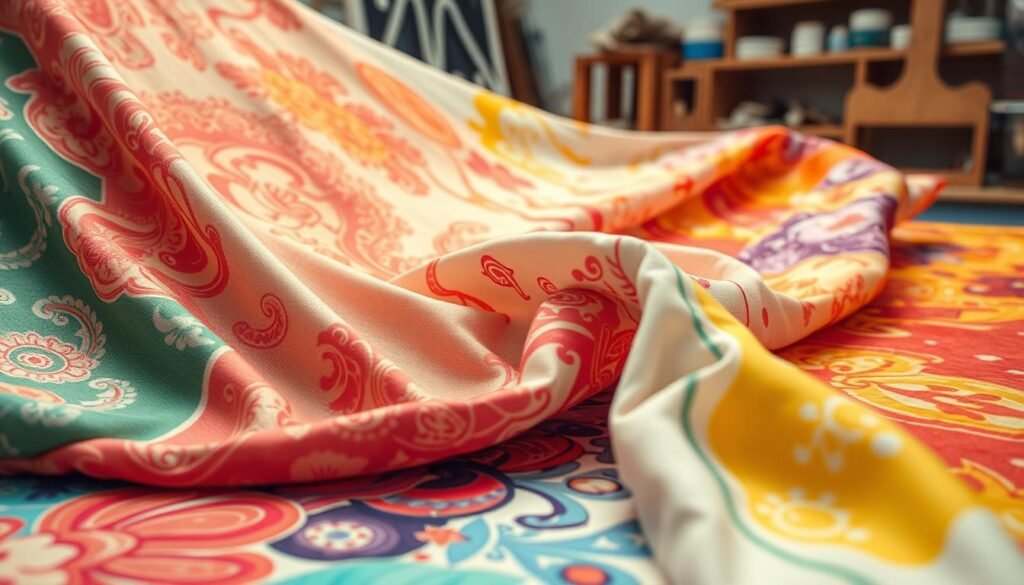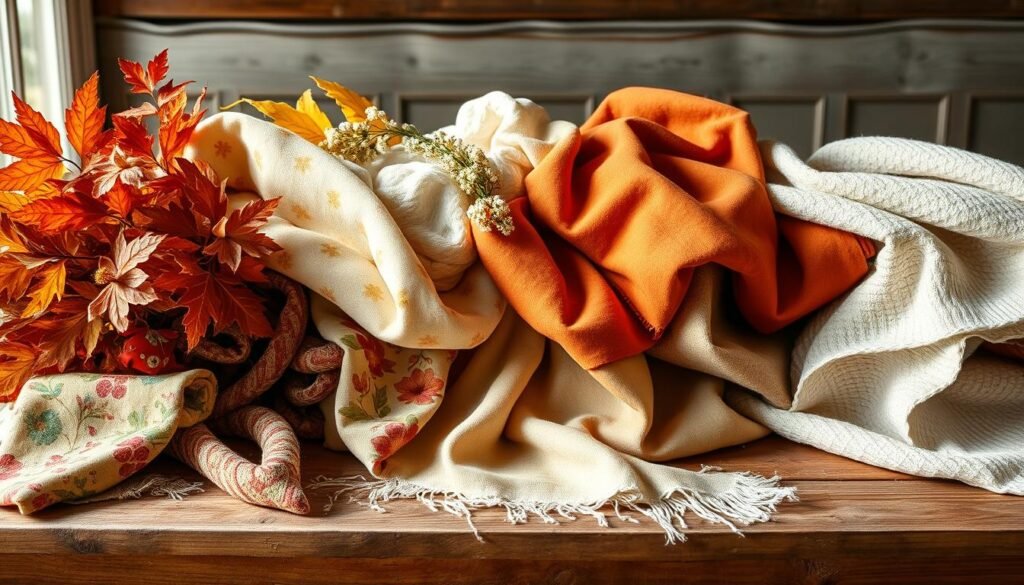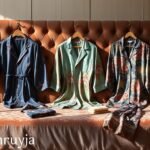“Fashion is what you’re offered four times a year by designers. And style is what you choose.” — Lauren Hutton.
In the world of custom clothing, your style springs from the fabrics you pick. Making the right fabric choice is crucial, whether you’re imagining the ideal cotton shirt or seeking out unique blends for special apparel. Knowing different fabrics enriches both the comfort and lasting quality of your designs. Cotton, the most popular natural fabric, is loved for its comfort and breathability1. Meanwhile, synthetic materials like polyester are favored in sports clothing for their lightness and ability to keep moisture away1. The fabric you choose is the foundation of your fashion adventure.
But choosing fabric for custom clothing isn’t only about picking one type; it’s about finding the right mix of comfort and durability through blends1. By learning about fabric weights and how they relate to wearability and versatility1, you can create clothes that fit not just the body, but also the season, occasion, or purpose. Looking into different blends, such as cotton/spandex, rayon/polyester, and poly-cotton1, shows us that the best fabrics blend functionality with style perfectly.
Key Takeaways
- Discovering the best fabric for your design is as crucial as the design itself.
- Cotton is championed for its natural comfort and breathability, perfect for custom t-shirts2.
- The introduction of polyester and its blends into custom clothing offers unparalleled durability and ease of care1.
- Fabric weight plays a key role in determining the garment’s comfort and seasonal suitability1.
- Blended fabrics combine the advantages of multiple materials to meet specific clothing needs1.
- Choice of fabric underpins the wearability and aesthetic appeal of custom-made apparel.
Introduction to Custom Clothing Fabrics
Custom clothing opens up a world of creativity. This world is greatly shaped by the types of custom t-shirt materials, bespoke apparel textiles, and personalized fashion fabrics chosen. Understanding these materials is crucial not just for their looks but for their function and best use in designs.
Cotton is famous for its breathability and soft feel. It’s a cornerstone in the custom t-shirt materials arena. Being the top natural fiber around, its versatility shines in many fashion styles, especially in sportswear blends for its comfort3. On the other hand, polyester leads in durability and keeping colors bright. It’s great in sportswear because it doesn’t shrink, wrinkle, or fade easily3.
There’s a growing interest in eco-friendly fabrics in bespoke apparel textiles. Plant-based polyester is one such green choice, though it’s not as tough as synthetic ones3. Then, there are silks like Charmeuse and Georgette that add a layer of luxury with their shiny look and smooth flow. These are perfect for fancy dresses and top-tier shirts3.
Dying methods can really change how fabrics look and feel. Using natural sources like fruits and flowers is better for the planet. Techniques like Shibori and Batik create beautiful, complex patterns. These are especially striking on fabrics like silk and cotton4.
When it comes to making personalized fashion fabrics unique, digital and screen printing are key. They let designers bring detailed and colorful designs to life with accuracy. Digital printing, for its part, has changed the game in making custom fabrics easy4.
In summary, choosing the right fabric is crucial in making custom apparel that not only looks great but also works well. When designers match fabric types with the intended use and style, they can make one-of-a-kind pieces. This taps into the full potential of custom t-shirt materials, bespoke apparel textiles, and personalized fashion fabrics.
Essentials of Cotton for Custom T-Shirts
Cotton is highly regarded in the fashion world for its classic touch and lasting features. It is the top pick for custom t-shirts. Comfortable cotton clothing and 100% cotton tees depend on fabric quality and care for their lasting charm and beauty.
The Timelessness of 100% Cotton
100% cotton is loved for being soft and breathable. It’s known for quality in the custom apparel scene. It’s perfect for custom t-shirt printing because it shows off bright ink colors well. Though softness varies across brands, products like the Next Level Apparel’s 3600 mix affordability with top-notch quality. Organic cotton is more eco-friendly. It uses less water and energy, making it great for the planet and durable for wear5.
5100% cotton is the best for screen printing. It’s versatile and withstands many washes. It’s not just traditional but stands out for its excellence.
Comparing Cotton Shirt Options
Let’s look at the differences in cotton-based custom t-shirts:
| Feature | 100% Cotton | Cotton Blend |
|---|---|---|
| Softness | Varies by brand | Enhanced with polyester or rayon |
| Durability | High (suitable for multiple washes) | Increased with synthetic fibers |
| Sustainability | Organic options available | Blends with recycled polyester or bamboo |
| Breathability | Excellent | Good, with added moisture-wicking in blends |
The table highlights the core benefits of cotton and its blends. These insights help make informed choices for comfortable cotton clothing and 100% cotton tees. Cotton fabric suits different needs. It offers solutions that focus on comfort, style, and being kind to the earth5.
Discover tailored apparel from sustainable sources. Check out custom silk pajamas that bring out personal style and care for the environment.
This comparison explains why cotton is fundamental in custom clothing. It’s chosen not only for its classic look but also for its versatility and quality that meet today’s fashion needs.
Poly-Cotton Blends: Durability Meets Comfort
Poly-cotton blends are a perfect mix of strength and coziness in textile. These fabrics are strong, thanks to durable polyester. But they’re also soft and comfy due to the cotton. This makes them ideal for everyday clothes and specific uniforms.
The mix of polyester and cotton gives us stretchy t-shirt materials. These are perfect for active wear because they’re comfortable and flex with you. The blend, like 65% polyester to 35% cotton, also helps pull moisture away from your skin during sports6.
The Advantages of Polyester in Blends
Polyester helps poly-cotton clothes last longer because it doesn’t fade or shrink. Clothing often has a 70% cotton to 30% polyester mix. This blend offers cotton’s softness with polyester’s toughness. It’s great for items that get washed a lot without losing their comfy feel7.
Recommendations for Poly-Cotton Blend T-Shirts
Choosing the right poly-cotton t-shirt means looking at the blend ratio. A mix of 80% cotton to 20% polyester is usually best for a soft yet durable shirt. This makes the shirt light and comfortable but also allows it to keep its shape and color over time7.
Poly-cotton suits various weather conditions, perfect for all seasons. Polyester in the blend helps the colors stay bright, especially outdoors. This is key for lasting color vibrancy in clothes7.
When picking a stretchy t-shirt material, think about what you’ll use it for and its durability. Always check the labels for the poly-cotton mix and how to care for it. This helps you get the most out of these modern, engineered fabrics.
Poly-cotton blends are becoming more popular. They meet many needs, from casual to work wear6. They are loved for being tough, comfy, and easy to care for. This makes them a top choice in many clothing sectors.
Tri-Blend Fabrics: The Pinnacle of Softness
Welcome to the world of tri-blend tees. Here, comfort, durability, and style come together. Tri-blend fabrics mix 50% polyester, 25% cotton, and 25% rayon. This mix offers a great solution for modern clothing needs8910. Premium soft t-shirts are known for their extreme softness. They are a top pick for brands like Bella+Canvas and American Apparel10.
The special mix of materials in tri-blend fabrics adds many benefits. Polyester gives durability and helps shirts dry quickly89. Cotton offers breathability and comfort. Rayon makes the fabric silky and flexible. The blend makes tri-blend tees not just versatile but perfect for daily wear or sports.
Caring for tri-blend fabrics is easy and keeps them looking good. Washing in cold water and air drying prevents shrinkage8. It also keeps the fabric soft. For custom printing, use water-based inks and the right pressure settings. This protects the fabric’s quality8.
| Brand | Composition | Attributes | Color Options |
|---|---|---|---|
| Bella+Canvas 3413C | 50% Poly, 25% Cotton, 25% Rayon | Softest, Smooth Print Surface | Multiple |
| American Apparel TR401 | 50% Poly, 25% Cotton, 25% Rayon | Lightweight, Great Fit | Varied |
| Next Level 6010 | 50% Poly, 25% Cotton, 25% Rayon | Flattering Fit, Soft Fabric | 24 Colors |
In conclusion, tri-blend tees offer durability, style, and comfort. This makes them a fantastic choice for anyone. They are great for sports, hanging out, or custom goods. Tri-blend fabrics promise quality and satisfaction for all wearers10.
Exploring Alternative Textiles for Unique Apparel
The fashion world is changing, with a shift to environmentally conscious apparel. New fibers are at the forefront of sustainability. Bamboo fabric, viscose, and other innovative textiles are great alternatives to traditional fabrics. They offer ecological benefits and practical uses.
Eco-Friendly Bamboo Fabric Features
Bamboo fabric is perfect for those who love environmentally conscious apparel. It’s not only soft but also friendly to the planet. Bamboo is a resource that can quickly renew itself. It has properties that fight microbes and wick away moisture, making it perfect for sportswear. Plus, making bamboo fabric needs less water and creates less waste than traditional cotton11.
Innovative Uses of Viscose and Hemp
Viscose, made from wood cellulose, feels like silk and is very adaptable. It’s often used in light clothes like tank tops and dresses. Its breathability and vibrant color retention are key benefits. Hemp is becoming popular too, thanks to its strength and low impact on the environment. It absorbs lots of CO2, improves soil health, and doesn’t need harmful chemicals to grow11.
These materials help us lessen our environmental impact and offer unique, green choices for clothes. The need for environmentally conscious and creative apparel is increasing. Thus, bamboo fabric, viscose, and hemp are becoming more crucial in the fashion industry.
Soft Fabrics and Screenprinting Compatibility
Choosing the right fabric for custom clothing is important. It affects the quality and durability of screenprinted designs. Different materials can change how your design looks and lasts over time.

Understanding Fabric and Print Interaction
Different fabrics work differently with ink. Cotton holds ink well and feels soft, making it great for screenprinting12. Polyester is strong and doesn’t wrinkle easily. But, it might not hold ink as well as cotton does13.
Tri-blend fabrics mix cotton, polyester, and rayon. They’re soft and hold ink well12. This mix is great for detailed designs. It shows off complex details perfectly.
Finding the Ideal Fabric for Vivid Designs
Choosing fabric is about more than feel. You must consider how it works with screenprinting ink. Cotton comes in several types, each offering benefits like comfort and clear prints13. Polyester is good for sports clothes. Yet, it’s hard to get bright colors on it12.
Eco-friendly fabrics like bamboo offer new chances for screenprinting. They’re good for the environment and work well with ink13. Testing fabrics before a big production run helps find the best material for your designs13.
Right fabric choice impacts how well a product performs and looks. Screenprinting on soft fabrics is key for quality. It pleases both the makers and the buyers with how the garment feels and appears.
Selecting the Right Fabric for the Right Garment
Choosing the right fabric for your clothing design is key. It’s not just about looking good. It’s about how the garment performs and feels. The right material ensures the clothing not only stands out but also works well for its purpose.
Different outfits need different types of fabric. For instance, leggings and swimsuits work best with stretchy fabrics like spandex. This fabric is known for its amazing stretch. Brands like Lululemon and Adanola use it widely14. Jeans and jackets, however, need something sturdy like denim. It’s famous for being one of the toughest fabrics15.
| Fabric Type | Properties | Common Uses |
|---|---|---|
| Stretch Nylon | High elasticity, durable | Activewear, sportswear |
| Fleece Back Fabric | Soft, cozy feel | Loungewear |
| Ribbed Fabric | Higher stretch and hold | Tight-fitting garments |
| Cotton | Breathable, soft | Streetwear, casual wear |
| Twill | Diagonal pattern, durable | Chinos, jeans |
Nowadays, designers love to mix things up with unique fabrics. They use unusual materials to add a special look and feel to their creations. For instance, athletic mesh makes everyday clothes into breathable sportswear perfect for intense activities14.
Knowing fabric features like stretchability and durability is essential. High-quality materials help clothes keep their shape and last longer. They’re also easier to take care of15. Choosing the right fabric also means paying attention to color and how it holds up over time15.
The decision on fabric is a mix of function, style, and vision. Making the right choice can greatly impact how a garment turns out. The best fabrics make clothes more enjoyable by offering comfort, style, and practicality.
The Role of Fabric Type in Seasonal Clothing Choices
Picking the right fabrics is key for adapting clothes to different seasons. This choice impacts comfort, use, and how eco-friendly clothes are. Designers and shoppers should focus on seasonal fabric selection, weather-appropriate textiles, and year-round clothing materials.
Matching Fabrics with Seasonal Needs
With each season comes new needs for fabric types. Spring and summer are perfect for cotton and linen because they’re light and breathe well. This helps keep people cool in hot weather16.
Winter, however, needs cozy fabrics like wool. Wool holds in warmth, making it a must-have for the chilly weather16. How well fabric matches the climate affects its usefulness all year.
Transitional Fabrics for Versatile Wardrobes
Some fabrics work well no matter the season. For instance, merino wool is great for both cold and warm days. It stays breathable and keeps moisture away17.
Fabrics mixing natural and synthetic fibers, like cotton and polyester, are both affordable and comfy. They’re good in many weather types18.
Choosing smart seasonal fabric selection is just the start. Adding textiles with new tech can make clothes even more adaptable. These advances can make fabrics more breathable, durable, and add features like UV protection. This is especially good for sportswear and clothes used throughout the year18.

| Fabric | Season | Properties |
|---|---|---|
| Cotton | Summer | Lightweight, Breathable, Comfortable |
| Wool | Winter | Insulating, Moisture-wicking, Warm |
| Linen | Spring/Summer | Strong, Breathable, Lightweight |
| Merino Wool | Year-round | Breathable, Temperature Regulating, Odor-resistant |
| Polyester-Cotton Blend | Year-round | Comfortable, Durable, Economic |
Using weather-appropriate textiles is not just about feeling comfortable. It also helps the environment by reducing the need for frequent wardrobe changes. The right material choices can make clothes more multi-use and long-lasting. This cuts down waste and encourages more sustainable fashion habits.
Conclusion
Choosing fabric for custom clothes is more than picking what looks good. It’s about making a statement and shaping the garment’s experience. Cotton is celebrated for its softness and being good for people with allergies. Polyester, on the other hand, lasts long and is easy to care for19. This guide has shown how important it is to know about fabrics like cotton and polyester. We’ve learned cotton needs a lot of water and polyester takes a long time to break down in landfills20.
Statistics show that since 1980, polyester has become more popular than natural materials. This is because of its practical uses in clothing20. Cotton still holds a big place in the market because it’s comfortable for everyday clothes and lounge wear19. But choosing fabric isn’t just about how it feels or lasts. We should also think about how it affects the planet from start to finish2019.
As we finish this guide, we think about all the things that affect our fabric choices. This guide aims to make understanding fabric easier, helping you pick materials that are good for your style and the planet. Whether you’re a seasoned designer or someone who loves custom clothes, let this guide be your map. It’s a world where new meets old, and you can create something truly special.
FAQ
What factors should be considered when choosing fabrics for custom clothing?
In choosing fabrics for custom clothes, think about how comfy and strong the material is. Also, consider how well it works with printing inks and what you’ll use the garment for. It’s important to think about the season and if the fabric has special features like drawing sweat away or fighting germs.
Why is cotton a popular choice for custom t-shirts?
Cotton is a top pick for t-shirts because it’s affordable and shows off colors well. It feels familiar and is easy to look after. But, the quality of cotton can vary, changing how comfy the final t-shirt is.
What are the benefits of poly-cotton blend apparel?
Poly-cotton blends are great because they mix polyester’s strength and low wrinkles with cotton’s comfort and airiness. This blend is chosen often for custom clothes that need to last a long time and still feel good.
How do tri-blend fabrics excel in custom clothing design?
Tri-blend fabrics combine cotton, polyester, and rayon. This mix gives a soft, adaptable, and high-quality feel. They’re especially good for high-end soft t-shirts that are meant to be worn a lot.
Can alternative textiles like bamboo, viscose, and hemp be used for custom clothing?
Yes, other textiles like bamboo, viscose, and hemp are great for custom clothes. Bamboo is awesome for workout clothes because it fights germs and pulls away sweat. Viscose is soft and performs well, while hemp is comfy and easy on the environment.
Why is it important to consider fabric and print interaction in custom clothing?
The way fabrics interact with ink affects how vivid, sharp, and long-lasting printed designs are. Choosing the right fabric ensures your printed designs look great and last on soft materials.
How does the type of garment affect the choice of fabric?
What you plan to use the garment for, and how much it needs to move, dictates your fabric choice. Stretchy knits are needed for items like leggings, while sturdy woven fabrics are best for items like denim jackets.
How should fabrics be matched with seasonal needs?
Choose fabrics based on how well they hold or let out heat to keep the wearer comfortable in different seasons. Silk chiffon and cotton lawn are perfect for summer. For cold times, thicker materials like wool are better.
Are there transitional fabrics that are suitable for year-round wear?
Indeed, certain fabrics and lightweight wool can be used all year, adapting easily to various temperatures. For instance, patchwork leather can be styled to fit different weather.
What role does a designer’s creativity play in fabric selection for custom clothing?
Designers use their imagination to pick unusual fabrics for specific clothes, breaking traditional rules. This creates distinctive, trend-setting outfits.
Source Links
- T-Shirt Fabric Guide: What Is the Best Fabric for T-Shirts?
- A Guide to Shirt Materials: Which Fabric is Right for You?
- An introduction to fabric selection for your fashion brand
- How to design your own fabric at home [FREE COURSE!]
- How To Choose the Best T-Shirt Material for Your Prints
- Cotton and Poly Cotton Fabric : Know everything – Fibre2Fashion
- Understanding Poly-Cotton & Cotton Blend Fabrics – Bigreams.com
- What Is Tri Blend: Discover the Unique Fabric Composition
- Tri-Blend VS Cotton – Determining Which Fabrics is Better
- What Is a Tri-Blend Shirt?
- What Are the Best Lower-Impact Fabrics and Fibres on the Market Right Now? – Good On You
- The Best Types of Fabrics & Materials for Apparel Screen Printing
- The Best Fabrics to Screen Print Shirts: A Complete Guide
- Clothing Fabrics Explained: Choosing the Right Fabrics
- What are the Factors to Consider in Choosing Fabric?
- Dress for the Seasons: A Fabric Guide for Seasonal Wear
- Fabric Choices for Seasonal Dressing
- The Importance of High-Quality Fabric for Clothing – A Guide to Elevat
- Cotton Or Polyester The Ultimate Guide For Your Clothing | Recovo
- Natural Vs Synthetic Fabrics: A Guide to Fabric




